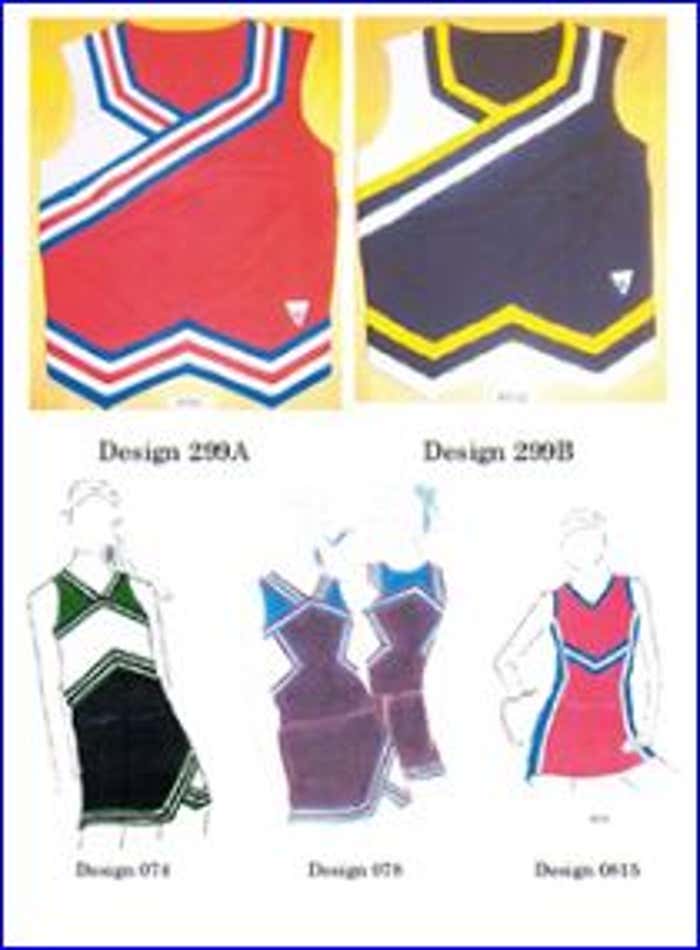
On March 22, 2017, the Supreme Court held in Star Athletica, LLC v. Varsity Brands that design elements of cheerleading uniforms may be protected under the Copyright Act. The 6-2 decision, written by Justice Thomas, clarified the scope of protection afforded to clothing designs and, more broadly, designs on useful articles.
Varsity Brands, Inc.—the country’s largest cheerleading supplier—owns more than 200 copyright registrations for two-dimensional designs consisting of combinations of chevrons, stripes, and other colorful shapes for its cheerleading uniforms. At issue in this case were the five pictured designs.
Varsity Brands sued Star Athletica, LLC, an upstart competitor, for copyright infringement. The District Court for the Western District of Tennessee granted Star Athletica’s motion for summary judgment, holding that the designs could not be conceptually or physically separated from the uniforms, and they were therefore ineligible for copyright protection. The Copyright Act makes “pictorial, graphic, or sculptural features” of the “design of a useful article” eligible for copyright protection as artistic works only if those features “can be identified separately from, and are capable of existing independently of, the utilitarian aspects of the article.” The Sixth Circuit reversed, concluding that the graphics were “separately identifiable” and “capable of existing independently” of the uniforms.
In affirming, the Supreme Court laid out a two-part test for when a feature incorporated into the design of a useful article is eligible for copyright protection: When the feature (1) can be perceived as a two- or three-dimensional work of art separate from the useful article; and (2) would qualify as a protectable pictorial, graphic, or sculptural work—either on its own or fixed in some other tangible medium of expression—if it were imagined separately from the useful article into which it is incorporated. “To be clear, the only feature of the cheerleading uniform eligible for a copyright in this case is the two-dimensional work of art,” the Court explained. “Respondents have no right to prohibit any person from manufacturing a cheerleading uniform of identical shape, cut, and dimensions to the ones on which the decorations in this case appear.”
Protection for fashion designs is a hotly contested topic because such designs do not fit neatly into any form of intellectual property under U.S. laws. Numerous parties filed amicus curiae briefs in the case, with the Council of Fashion Designers of America arguing that a ruling for Star Athletica “would have a swift and deleterious effect” and leave fashion designers “defenseless against copyists.” Other groups, meanwhile, argued that protection for useful items should remain the province of patent law, which has stricter limits on eligibility and duration.
Justice Breyer, joined by Justice Kennedy, wrote a strenuous dissent which did not disagree with the majority’s separability test but argued that the designs at issue could not be perceived as works of art separable from the cheerleading uniform because when “imaginatively remov[ed]” and placed on a canvas, the designs would still possess the contours of a cheerleader’s dress. This difference of opinion suggests the difficulties that lower courts may have in applying the Court’s separability test in practice.
Moreover, Justice Breyer voiced concerns with the effect of the ruling on the fashion industry. “A decision by this court to grant protection to the design of a garment would grant the designer protection that Congress refused to provide,” Justice Breyer wrote. “It would risk increased prices and unforeseeable disruption in the clothing industry, which in the United States alone encompasses nearly $370 billion in annual spending and 1.8 million jobs.”
The Supreme Court’s ruling does not fully resolve the question of whether the designs at issue merit copyright protection, however, as the case will now return to the trial court on the question of whether the designs possess enough originality to be protected by copyright—a separate question from the one addressed by the high court.
While the reach of this ruling remains to be seen, under the standard set forth in Star Athletica, separable artistic elements of useful articles, from apparel to furniture, may be easier to register and protect, allowing designers to become more aggressive in preventing copying of their designs. As the lower courts interpret and apply this significant ruling, we are likely to see more cases addressing the scope of copyright protection for artistic elements of useful articles.
* * *
For more information on copyright issues, please see the following Socially Aware articles: Second Circuit Clarifies “Repeat Infringer” Policy Requirement for DMCA Copyright Safe Harbors; New Copyright Office Rule Creates Potential “Gotcha” for Blogs and Websites Hosting User-Generated Content; The Kirtsaeng Opinion: Supreme Court Guidance on Attorneys’ Fees Awards in Copyright Cases; and Do Not Go Gentle Into That Jurisdiction: No “Situs of Injury” Merely Because Copyrighted Material Is Accessible.